Patoli (plural: Patoleo) or Patholi are sweet stuffed rice rolls which are steamed wrapped in turmeric leaves. It is a common dish during Ganesh Chaturthi celebrations in Goa and Konkan regions of western India. Since there’s a unique technique involved in this recipe, the preparation and cooking of this dish is laborious. However, the ingredients used in it are simple and basic. It is vegan and since rice flour is the main ingredient, the dish is gluten-free too.
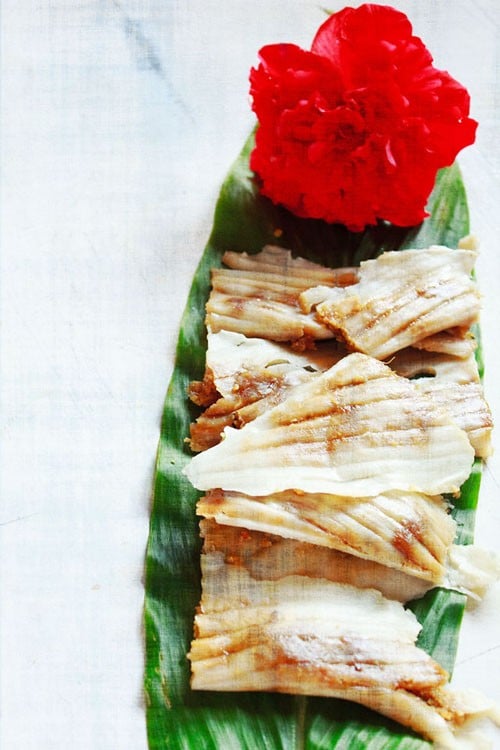
What is Patoli
Rice rolls stuffed with fresh coconut and jaggery, and then steamed result in the dish named Patoli or Patoleo. The stuffing mixture may be flavored with spices like cardamom powder, nutmeg powder and dry fruits or nuts.
What makes Patoli extra special is the fact that method of cooking involves steaming these rice rolls in fresh turmeric leaves. July to September are the months when the markets in Goa and the Konkan belt of India are abundant with fresh turmeric leaves.
Table of Contents
When the Patoli rolls are steamed in these leaves, they acquire their beautiful sweet and floral fragrance, making this dish all the more desirable and delectable. Patoleo are usually made in Gauri and Ganesha festivals in this region.
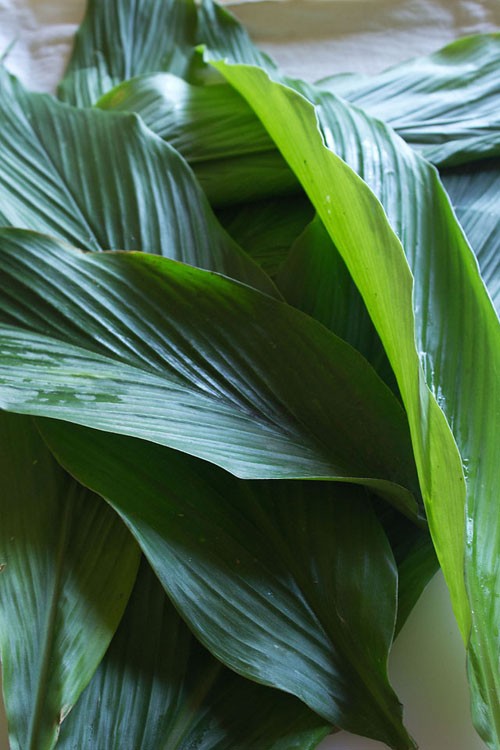
The Christian community uses a smearing of rice paste on the turmeric leaves, and cook the Patoli in a traditional steamer during their harvest festival.
Some of the sweets and desserts in the Indian food repertoire are loaded with fats and sugar. Patoli is a welcome change!
Thin and soft steamed rice covers stuffed with a heavenly coconut and melted jaggery mixture infused with the scent of spices and turmeric leaves.
About This Recipe
My mom too makes Patoli and this is her recipe only. She uses a non-fermented batter which she makes from scratch by soaking and grinding rice.
I have taken the easy route by making this dish with fine rice flour. Patoli tastes similar to a Modak except for the scent from the turmeric leaves.
There are a few variations of this delish sweet in the Indian cuisine. A similar variant Ela Ada is made in Kerala with plantain leaves instead of turmeric leaves.
In Odisha another variation called Enduri Pitha is made with an outer layer of fermented urad dal and rice batter stuffed with a sweetened paneer filling, steamed in turmeric leaves.
As I mentioned earlier, the fresh turmeric leaves used to steam these sweet rice rolls makes all the difference. This is definitely the USP of Patoli.
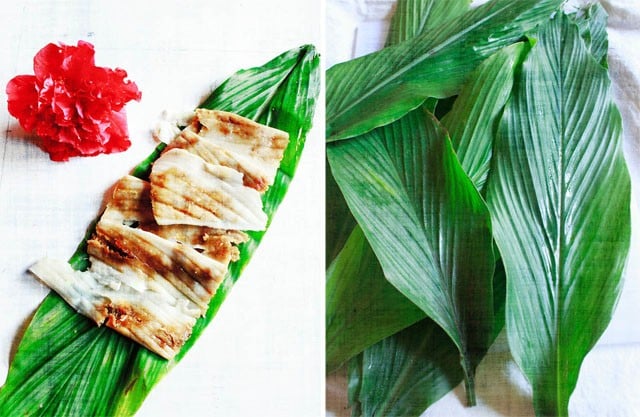
You’ll know this while steaming these delicacies, as your kitchen will be filled with the divine aroma from these. If you can’t source turmeric leaves, steam the Patoleo in banana leaves.
Turmeric leaves are used to bring flavor and a lovely fragrance to any dish. So they are used to steam food or added to rice and sweet dishes. On occasions I also make Idli that are steamed in these fragrant leaves.
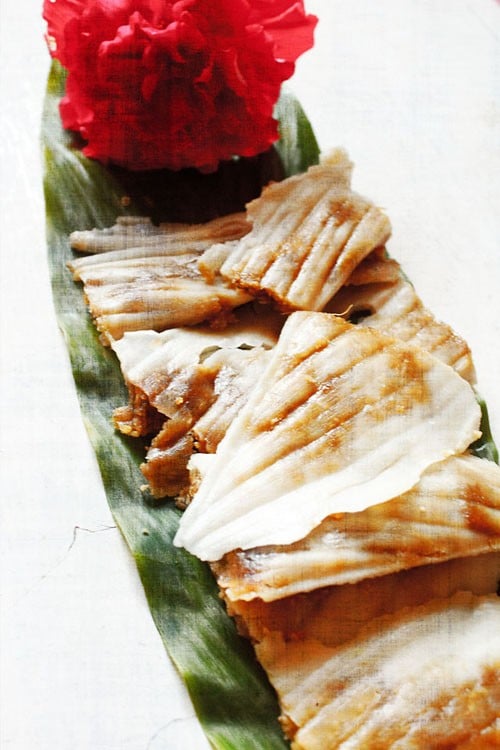
The procedure of preparing a Patoli takes a lot of patience and efforts. But eventually, you’ll find it all worth. What I also like about this delicacy is that it is vegan, gluten-free, oil free and a healthier choice of a sweet dish.
How to make Patoli
Prepare Batter
1. In a pan or bowl, mix 2 cups rice flour and ½ teaspoon salt with about 1.5 to 2 cups water to make a thick batter. The batter should be thicker than a Dosa Batter.
It should not be runny when spread on the leaves. Depending on the quality of rice flour, you can add less or more water than what I have added in the recipe.
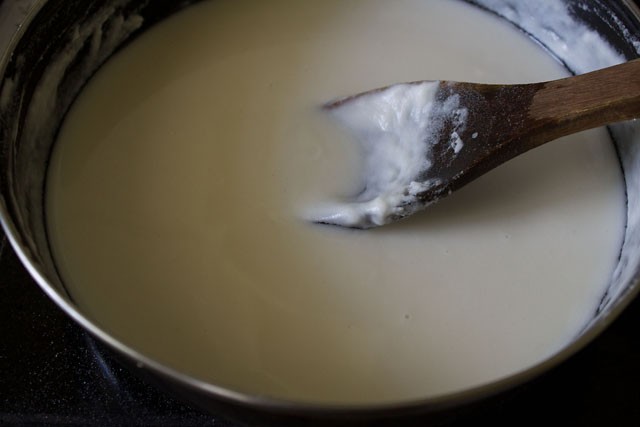
Make Sweet Filling
2. Mix 2 cups fresh grated coconut, 1.5 to 2 cups powdered jaggery, 1 teaspoon green cardamom powder and 1 to 2 pinches grated nutmeg in a plate or bowl.
Note that I have used fine jaggery powder. If you chop jaggery, then cook it with the coconut and cardamom powder for 2 to 3 minutes on medium heat.
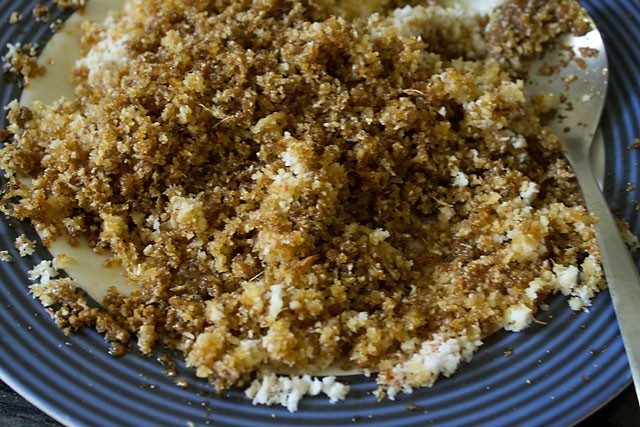
Make Patoli
3. Now, rinse 8 to 10 large or 18 to 20 small turmeric leaves. Wipe them dry. Slice the stalks from the leaves.
Take each leaf and smash lightly the middle vein of each leaf with a pestle. This helps in rolling the leaves easily. You can also scrape off the thick center vein with a knife.
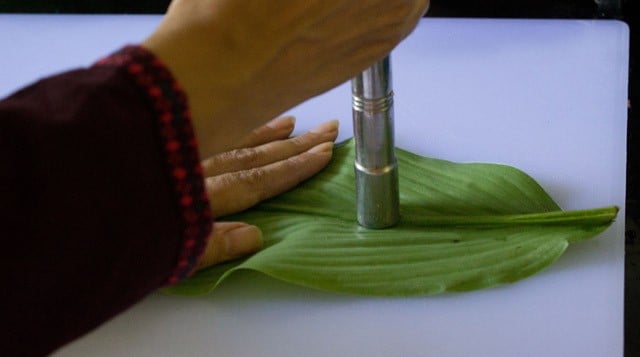
4. Spread the rice batter on the leaf. Cover the complete leaf.
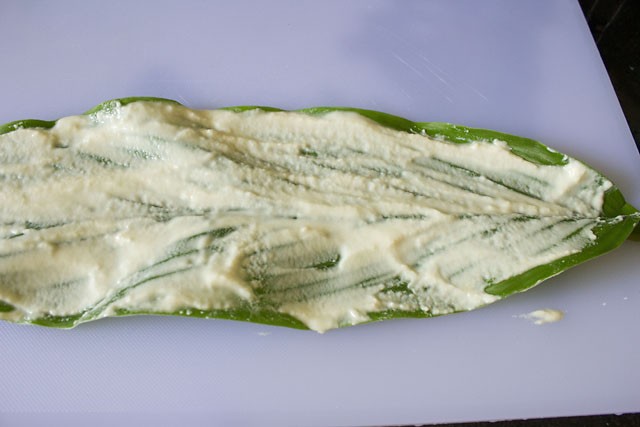
5. Place the coconut-jaggery filling in the center of the leaf.
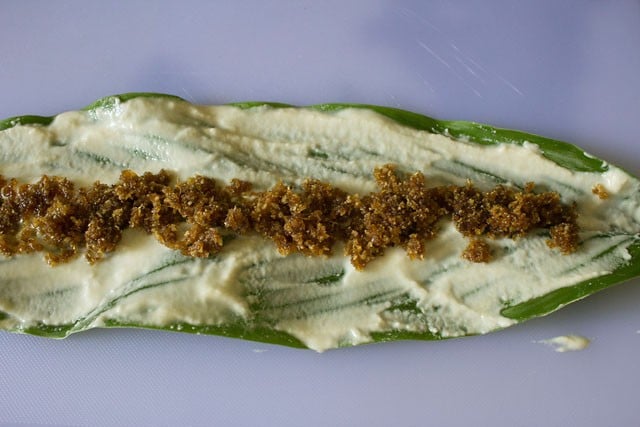
6. Fold one side down and press the edges. You can fold the leaves vertically or horizontally.
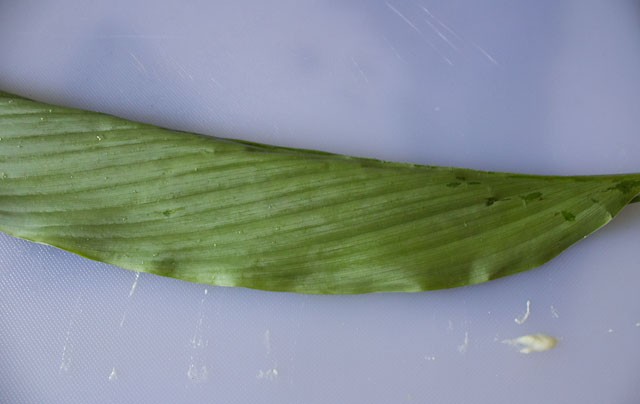
7. Since I had long leaves, I had cut the leaves into 2 or 3 parts. If you have small leaves, you can keep them whole and intact.
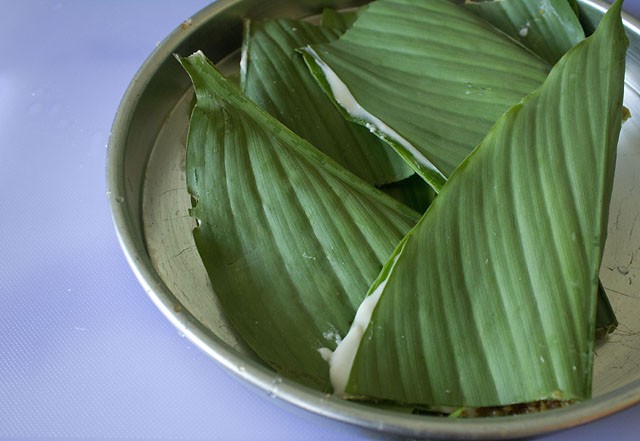
Steam Patoleo
8. Place the stuffed leaves on an idli steamer rack or any steamer lid or rack.
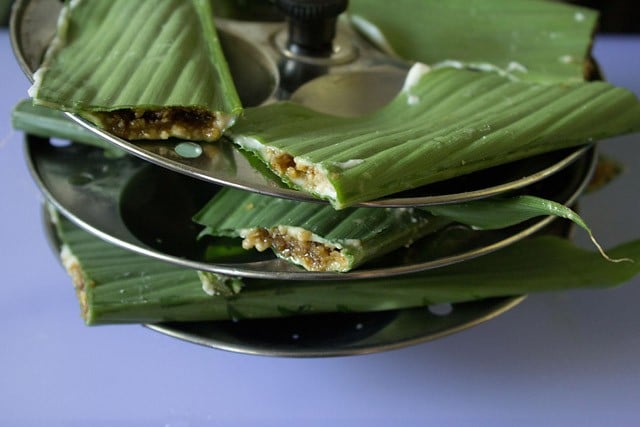
9. Steam these for about 10 to 12 minutes or till done. Remove once steamed.
You can use either the pressure cooker or idli cooker for steaming. If you have a small steamer, you will have to repeat the whole process. Add about 1.5 to 2 cups of water while steaming.
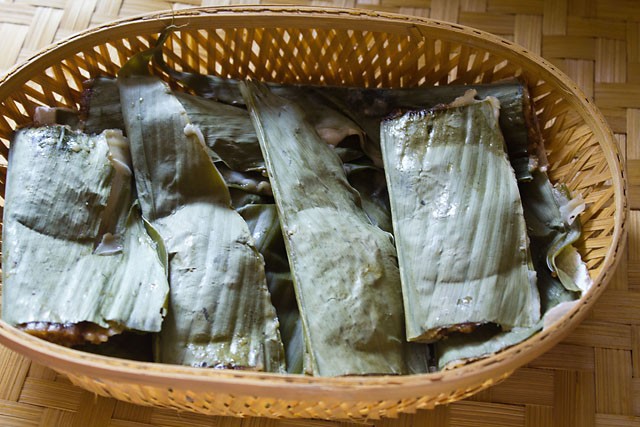
10. When warm, gently remove the turmeric leaves from the steamed rolls and serve immediately. Patoli can be had plain or with drizzled with some ghee or with a side of coconut milk or milk.
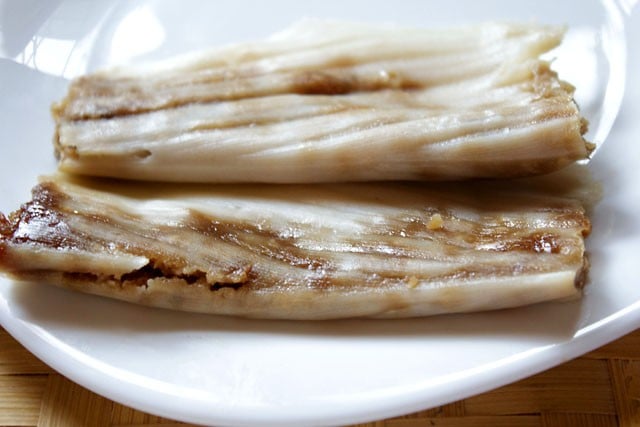
My Loss, Your Gain
One day while making the Patoli, I got a call from someone and I had to step out of my home because of the urgency. I had kept some Patoleo for steaming and told my sister to keep a check on that batch till I returned. My sister did prepare the remaining rolls, but stacked them one above the other.
Due to the steam, all the Patoli rolls stuck to each other. It was super difficult to separate them and we had a tough time to take out a few intact ones, which I could use for photography. It was already late and dark amidst this mayhem. So, I had to manage with some not so good-looking shots!
I hope you learn from this episode that you must not keep freshly steamed Patoli rolls stacked on top of each other, ever! But do go ahead and make this dish at home. Your family’s going to thank you for it. This is my assurance!
Expert Tips
- Adjusting Batter Consistency: More rice flour can be added in case the batter becomes thin. Some more water can be added in case the batter is very thick.
- Jaggery Amounts: As per your taste and palate preferences, you can adjust the sweetness in the filling by adding less or more jaggery.
- Turmeric Leaf Replacement: You can swap the banana leaves with turmeric leaves, if you wish.
- Scalability: The recipe is scalable to make a small portion or more servings.
More Ganesh Chaturthi Recipes To Try!
Sweets Recipes
Sweets Recipes
Ladoo Recipes
Please be sure to rate the recipe in the recipe card or leave a comment below if you have made it. For more vegetarian inspirations, Sign Up for my emails or follow me on Instagram, Youtube, Facebook, Pinterest or Twitter.
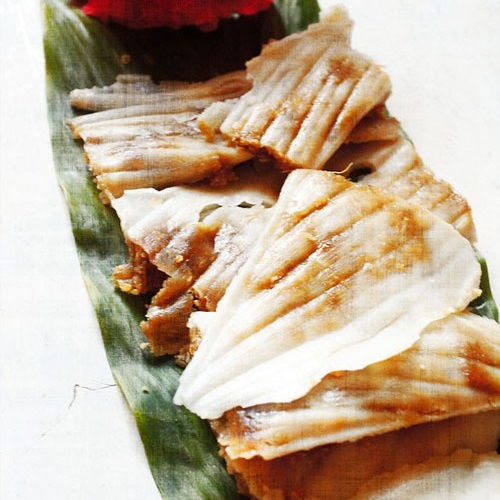
Patoli Recipe | Patoleo (Steamed Rice Rolls)
Ingredients
For the batter
- 8 to 10 turmeric leaves – large or 18 to 20 small leaves
- 2 cups Rice Flour – finer variety
- ½ teaspoon salt or as required
- 1.5 to 2 cups water – add more if required
For the sweet filling
- 2 cups fresh grated coconut
- 1.5 to 2 cups jaggery powder – adjust according to your taste
- 1 teaspoon green cardamom powder
- 1 to 2 pinches grated nutmeg
- choice of nuts – optional
Instructions
Preparing the batter
- Mix the rice flour, salt and water to a thick batter
- Keep aside for 30 minutes.
Preparing the filling
- Mix all the ingredients for the filling and set aside to make a thick batter.
Making patoli
- Take the turmeric leaves and rinse them in water first a few times. Drain the water.
- Wipe each leaf dry with a kitchen towel. Make sure there are no water droplets on the leaves.
- Smash lightly the middle vein of the leaf with a pestle or just slice it thinly with a knife without breaking the leaf.
- Cut the base stalk of the leaf.
- Spread the rice flour batter evenly on the leaf.
- Add the filling in the center of the leaf.
- Now fold the leaf gently horizontally or vertically.
- Press the edges.
- Steam the patholi on medium heat for about 10 to 12 minutes or till the rice layer has firmed and cooked well.
- When warm, remove the cooked turmeric leaves.
- And serve Patoli with some coconut milk or milk or ghee.
- These can also be had as is.
Notes
- Use good quality rice flour and make sure it is not rancid.
- Adjust the amount of jaggery according to your preferences.
- Feel free to add some chopped nuts like cashews if you like.
- The batter should have a thick to medium-thick consistency. Ensure that it is neither too thick nor thin and runny.
Nutrition Info (Approximate Values)
This Patoli Recipe from the archives was first published in September 2012. It has been updated and republished in February 2024.
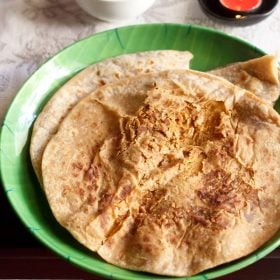
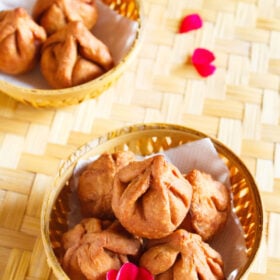
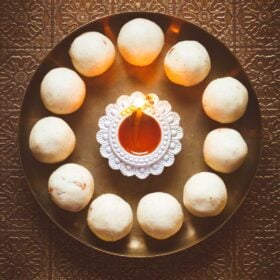
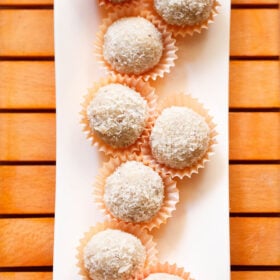








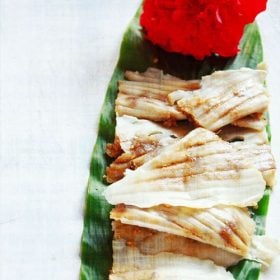
Hi,
In Kerala we call this “ila ada”. Ila mean leaf.
We use small pieces of plantain leaves to make this. Rice flour and wheat flour can be used.
Thanks for sharing the info and I do know about this version from Kerala. Thanks again.
Thank you for this amazing recipe! I made Patholis today and my family loved them 😊 God bless you Dassana!
Thank for your kind wishes and also for your feedback on the recipe. Good to know that your family loved the patholi.
Loved this simple recipe and easy to follow instructions. Followed the recipe to a t and the result was outstanding. I had been growing turmeric for a few months and used to think about making this sweet with turmeric leaves. Today had the courage to try it because it was Ganesh Chaturthi and because Dassana had this amazing simple to follow recipe. I am so glad I made it but I ate most of what I made. have to pace myself next time I make this. Thank you so much Dassana!
Thanks a lot Nima. The recipe is easy and I am glad you made it. Yes, it is addictive. Thanks again and wish you a Happy Ganesh Chaturthi festival.
Hey…This looks tempting and I am going to try it this weekend. Quick Qs:
1. If Modak and Patholi are similar except the turmeric leaf aroma, then shouldn’t the proportion of the rice to water be the same? I am a bit scared of rice dough, since the last I tried modak, by the time I finished assembling half the batch, the dough had gone cold and wouldnt take modak’s shape for the remaining batch or would crack. Any tips?
2. If I don’t find Turmeric leaves, can I go with Banana leaves or other options? would Banana leaf have their aroma too?
Your pics are very tempting 🙂
The are similar but not same. For patholi a batter is made from the rice flour. The amount of water will depend on the texture of flour. In the recipe I have fine textured rice flour which will need less water. If a semi-fine or coarse textured flour is used, more water will be needed. When you made the modak, you must have added less water. The dough stays soft even after it cools and can be shaped. But it should not become dry, so always keep it covered with a lid or a kitchen towel. If you get cracks, then spread a bit of water in your palms and shape the dough. Yes you can use banana leaves or just steam them plain. Turmeric leaves gives a really good fragrance though. Banana leaf will have a different aroma and it is very mild and will go unnoticed. Thanks.
hi. nice post. i am from goa and patoli is goan traditional dish, we make patolis at nagpanchami and ganesh chaturthi also. main method of making patoli is to making dough of rice flour , no need to make batter so it will not stick to the leaves after cooked.. i never heard batter recipe in goa goans make dough out of it. dont worry about the dark color.. try it
thanks harsha. i will try with the dough variation this festive season. my mom is from goa and has been making patoli since ages. this is how i learnt it from her and this how i make it even today with the rice batter. if the rice batter is not thin, then the the patolis does not stick to the haldi leaves.
Hi Dassana,
I am a fan of your blog and have tried quite a few of your recipes. Thank you for the photos and several thoughtful tips. We are from Mangalore and my mother always mashes banana into aata for the outer shell of the patHoli. This mix of aata and mashed banana is spread on the haldi paan before filling it with the coconut mix. The aroma and taste are amazing. Do try this variation when you get a chance.
Thank you Chand. Glad to read your feedback. Thanks for sharing the variation too. I will give a try and I am sure it will be delicious.